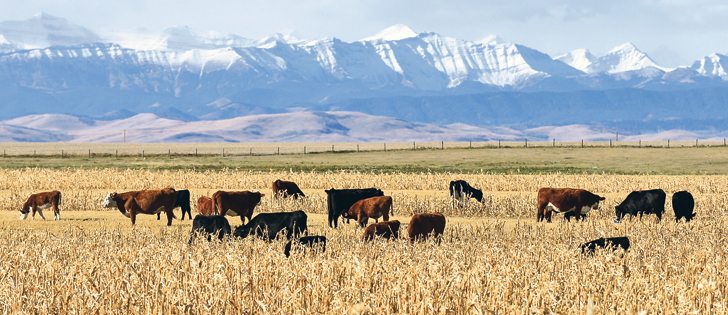Putting cattle out to graze standing corn is becoming more common on the Prairies.
New hybrid corn varieties that require less heat have offered more alternatives for winter grazing. It is a high energy, nutritious feed with respectable yield potential that maintains quality through the winter.
Research has shown 1,790 pounds per acre of forage can sustain a 1,500 lb. cow through the winter. Whole standing corn far surpasses that.
At 50 percent starch, corn cobs provide enough energy to keep cows warm and in some cases, gain weight as they work through a field.
Read Also

Trump’s tariffs take their toll on U.S. producers
U.S. farmers say Trump’s tariffs have been devastating for growers in that country.
“When we go into a winter feeding situation with the cows, we are trying to manage body condition in those winter months,” said researcher Bart Lardner of the Western Beef Development Centre.
Research at the centre found grazing cows cost 70 cents to $1.42 per day compared to dry lot feeding costs of about $2.50 per day.
Corn meets their energy needs during the cold winter months but cattle still need to be monitored.
“Energy requirements of that beef cow (during winter) ramps up considerably. The wind chill factor combined with the cold temperatures is the biggest thing,” Lardner said in an Oct. 12 webinar sponsored by the Beef Cattle Research Council.
Corn can work as a wind shelter but additional protection and extra bedding may be needed for the colder, windy periods.
Cows may take a day or two to adjust to standing corn when they are first turned into a field.
Cows will eat the cobs first, then the stalks and husks. Figuring on an average cow weight of 1,400 lb., each animal will eat 30 to 40 lb. of dry matter or about 2.5 percent of its body weight.
Lardner recommends splitting a field into smaller paddocks with electric fences and offering the cows four or five rows of corn at a time so they are forced to consume cobs, tassels and stalks before moving onto other sections of the field.
Producers should add a round bale of grass hay or straw for added fibre because too much starch from the cobs can lead to rumen acidosis or founder.
Samples containing the entire plant should be tested to make sure all nutritional needs including protein are met.
Disease in corn can be a problem in wet years, so samples should be checked for fusarium and other toxins.
If protein levels get low close to calving, consider adding a supplement. It is also important to add a well-balanced mineral program that includes micronutrients like copper, manganese and zinc.
Weaned beef calves can also eat corn but they may need supplements.
One research trial showed calves in the field gained about 1.3 lb. per day but this did not affect their feedlot performance. They may be a bit lighter when they enter the feedlot but they made up for it with weight gains later.
Corn is a high cost crop. Individual farms may report some differences but the beef development centre calculated growing corn costs $206 to $223 per acre.
“It is a high input, high risk crop. You are putting a lot of dollars per acre for grazing beef cows, so do it right,” Lardner said.
Look for crop heat units at: www.farmzone.com or bit.ly/2yDWgNH
A full analysis on corn grazing may be viewed at www.wbdc.sk.ca
















